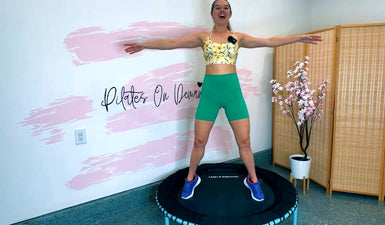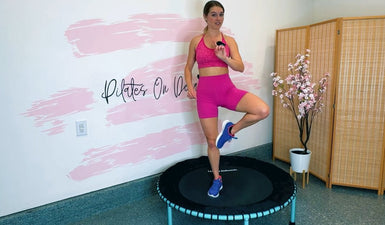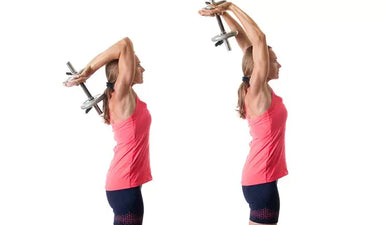Affecting millions of individuals yearly, back pain is one of the most common issues among adults living in the United States. Whether it's overall discomfort, upper back pain, or lower back pain, it can substantially disrupt daily activities. Many people are seeking alternative approaches to gain relief even if traditional treatments including prescription medicines and physical therapy are often prescribed. Rebounding is one such strategy that is really trendy right now. The several advantages of rebounding will be covered in this article together with how it may alleviate back discomfort and how best to include it into your program.
Why Rebounding Is Effective for Back Pain Relief
Back pain alleviation benefits of rebounding, or exercising on a mini-trampoline, include the following:
- While rebounding, the trampoline's shock-absorbing surface lessens the pressure on the spine and joints than in high-impact activities. Those with ongoing back pain would find this ideal.
- Better Circulation: By improving blood flow, the mild bouncing helps the spinal tissues receive oxygen and nutrients. By lowering inflammation, a major source of pain, this promotes recovery.
- Core Strengthening Rebounding strengthens your core muscles, which helps to improve posture and lessen lower back discomfort.
- Spinal Alignment: The soft motion promotes modest decompression and spinal alignment, which helps relieve nerve pressure, particularly in situations like ruptured discs.
- Stress Reduction Stress can lead to back stiffness, but exercise naturally lowers it. A great approach to encourage relaxation and release endorphins is to rebound.
Stretches and Exercises for Lower Back Pain on a Rebounder
If rebounding is new to you, begin with easy, secure movements:
- Standing on the rebounder with your feet shoulder-width apart, gently, under control bounce to warm muscles and boost circulation.
- Lean your pelvis gently forward and backward while standing to release lower back strain.
- Core twists—placing your hands on your hips and turning your body side to side—help to boost flexibility and engage your oblique muscles.
- If standing causes pain, seat on the rebounder and gently bounce to strengthen your lower back and core.
- Before starting any new exercise program, especially if you currently have a back condition, always seek your doctor's clearance.
Always get your doctor's approval before beginning a new workout regimen, particularly if you already have a back ailment.
The Best Ways to Reduce Back Pain with a Rebounder
In order to reduce the risk of damage and enhance benefits:
- Start Slowly: Start with quick workouts (5–10 minutes) and extend them progressively as your body gets used to them.
- Focus on Form: To maintain stability, keep your back straight, and avoid bending too much.
- Pay Attention to Your Body: Pause right away if you feel pain, and get medical help.
- Include Stretching: Before and after rebounding, do some hamstring and lower back stretches.
- Invest in a high-quality rebounder: For added safety, get a strong rebounder with enough shock absorption.
Additional Benefits of Rebounding
In addition to its effect on back pain, rebounding has several other health advantages:
- Weight control: It's a good way to burn calories and help you keep your weight under control.
- Enhanced Balance: Consistent usage lowers the chance of falls by improving coordination.
- Detoxification: The lymphatic system is stimulated by rhythmic action, which helps to eliminate toxins.
- Mood Enhancement: Rebounding is a pleasant and stress-relieving activity that supports mental health.
When to Avoid Rebounding
Although rebounding is typically safe for most individuals, not everyone is a good fit for it. The following conditions should be discussed with a physician before beginning rebounding exercises:
- Severe damage to the spine or back.
- Just completed joint or spine surgery.
- Dizziness or problems with balance.
- More severe osteoporosis.
Are you prepared to return to your former, healthier self? Give rebounders a try to see the advantages for yourself!
References
Bhattacharya, A., McCutcheon, E. P., Shvartz, E., & Greenleaf, J. E. (1980).
"Body Acceleration Distribution and O2 Uptake in Humans During Running and Jumping."
Journal of Applied Physiology, 49(5), 881-887.
DOI: 10.1152/jappl.1980.49.5.881
Zhou, F., Zhu, Z., & Zhang, M. (2015).
"Effects of Exercise on Chronic Lower Back Pain: A Meta-Analysis."
Medicine, 94(50), e2319.
DOI: 10.1097/MD.0000000000002319
Wells, R. P., & Greig, M. (2001).
"Biomechanical and Physiological Responses to Rebounding Exercises."
Applied Ergonomics, 32(1), 71-76.
DOI: 10.1016/S0003-6870(00)00043-6


























0 comments